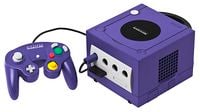| Nintendo GameCube | |
|---|---|
 | |
| Manufacturer | Nintendo |
| Type | Video game console |
| Generation | Sixth generation |
| First available | |
| CPU | IBM PowerPC "Gekko", 486 MHz |
| GPU | ATI "Flipper", 162 MHz |
| Media | 4 cm optical disc |
| System storage | Nintendo GameCube Memory Card |
| Controller input | Nintendo Gamecube controller |
| Connectivity | Nintendo GameCube Broadband Adapter and Modem Adapter |
| Predecessor | Nintendo 64 |
| Successor | Wii |
| Article on Nintendo Wiki | Nintendo GameCube |
The Nintendo GameCube (ニンテンドーゲームキューブ, Nintendo GameCube), also known as GCN or simply GameCube, is the fourth gaming console released by Nintendo in 2001. Super Smash Bros. Melee is one of its games, and its top-seller. The original model of its successor, the Wii, is backward compatible with the Nintendo GameCube, capable of playing all of its games and accepting its controllers and Memory Cards. Various Wii games have allowed use of a GameCube controller as a way to have a more traditional way to play, including Super Smash Bros. Brawl. The control scheme in Brawl works much like it did in Melee.
General Information
The Nintendo GameCube is unique in that its discs are smaller than any other game disc, utilizing a proprietary variant of the 8 cm MiniDVD. The controller features a considerably different layout from the Nintendo 64 controller. The C-buttons are replaced with a C-Stick which is identical in function, its shoulder buttons are pressure-sensitive, and sports a new binary wing grip design as opposed to the Nintendo 64 controller's ternary wing grip design, along with many other differences. It is the first Nintendo console to introduce online play, although in an extremely limited, decentralized manner. The system sold 21.74 million units worldwide.
In the Super Smash Bros. series
Super Smash Bros. Melee was released for the system on November 21st, 2001 in Japan, December 3rd, 2001 in North America, May 24th, 2002 in Europe, and May 31st, 2002 in Australia.
Various fighters in the Super Smash Bros. series originate from games originally released for the Nintendo GameCube. In Brawl, Ike, Toon Link and Olimar debuted as fighters, followed by Bowser Jr. and Villager (only considering outside Japan) in SSB4, and finally, Dark Samus in Ultimate.
The Nintendo GameCube appears within Super Smash Bros. Melee as a trophy, with its description breaking the fourth wall. It also appears as a platform in Luigi's Target Test in Melee in the center of the stage. In addition, the background of the Trophy Hoard room in Melee contains a GameCube (with controller) along with several other gaming implements, including a Game & Watch handheld, a GameBoy and a N64 containing a copy of the original Super Smash Bros.
Trophy description
Nintendo's latest bundle of joy arrived in North America on November 18, 2001, and video-game fans rejoiced. This little beauty is sleek, compact and full of cutting-edge technology. Incorporating optical media for the first time, the Nintendo GameCube was truly born to play. Rumor has it that Super Smash Bros. Melee is a software title for this wondrous device.
Nintendo's latest bundle of joy arrived in Europe in May 2002, and video-game fans rejoiced. This little beauty is sleek, compact and full of cutting-edge technology. Incorporating optical media for the first time, the Nintendo GameCube was truly born to play. Rumor has it that Super Smash Bros. Melee is a software title for this wondrous device.
Gallery
Trivia
- The GameCube is the only console to have a Super Smash Bros. game available during its launch year.
| Nintendo consoles | |
|---|---|
| Home consoles | Color TV-Game 15 · Nintendo Entertainment System · Super Nintendo Entertainment System · Virtual Boy · Nintendo 64 · Nintendo GameCube · Wii · Wii U |
| Handheld consoles | Game & Watch · Game Boy · Game Boy Color · Game Boy Advance · Nintendo DS · Nintendo 3DS |
| Hybrid consoles | Nintendo Switch |